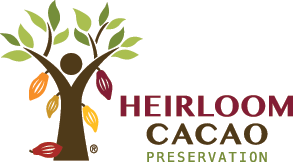/Chocolate Resources/Chocolate Blog/Costa Rica loses a major source of organic cacao

Costa Rica loses a major source of organic cacao

Cacao farmers face economic realities that can lead to tough decisions - including selling their farms

A cacao flower blooming on the tree
When you think of Costa Rica, you may not think of cacao or chocolate – for many people, Costa Rica brings up memories of sun-filled beach vacations or time spent exploring tropical jungles. But there are also farmers growing cacao and chocolate makers who are making chocolate. Unfortunately, like so many places growing fine flavor cacao in the world, the economic realities for small farmers can make continuing to grow cacao extremely challenging. We have just learned of one such story.
We were very, very saddened to hear that Hugo Hermelink sold his 110 hectare cacao farm, FINMAC, in August 2017 to a neighboring pineapple plantation. His 110 hectares of organic fine flavor cacao trees will be cut down to give way to pineapple, an environmentally unfriendly crop.

Hugo teaching participants during Ecole Chocolat's program in Costa Rica
According to Julio Fernandez and George Soriano of Sibu Chocolate, friends and clients of Hugo, “The destruction of FINMAC represents a loss of 20% of the country's total production of cacao and of most of Costa Rican organic cacao production. Hugo had been struggling for years as his trees got older and costs to renew the plantation seemed to be too high. This also reveals how hard it is for organic producers to survive. It's ironic that those who take care of the environment, their workers, the local fauna, the aquifers etc. are the ones who have to pay for expensive certifications, spend on infrastructure and prove their commitment over and over. Big agriculture, on the other hand, can disregard the environment and neglect their worker's health and safety with no consequences. The world is upside down.”

Transporting the harvest pods on the FINMAC cacao farm
Julio and George see this crisis in the Costa Rican cacao industry as an opportunity to mobilize cacao farmers and chocolate artisans. We support them in that effort and will continue to make sure our students are educated on the perilous future of fine flavor cacao sustainability and work even harder to ensure the success of the Heirloom Cacao Preservation (HCP) Fund.

Cacao pod train arrives at the cracking facility
We wish Hugo much success in his other chocolate ventures and understand that business decisions have to be made. We thank him for sharing his philosophy of cacao growing, expertise in organic farming and skill in producing fine flavor chocolate with our 100+ participants of our Cacao and Chocolate Making in Costa Rica program over the last 9 years.

Feeling the heat of cacao fermentation.
This story is just one example of some of the larger challenges that exist within the fine chocolate industry. It’s so important that we continue to educate consumers about why fine chocolate costs more, and that the vast majority of certifications say nothing about the flavor or quality of the beans used to make chocolate. If we want to ensure that we continue to have diversity in chocolate flavor, then we have to support chocolate makers sourcing cacao from these small farms. It would be awful to live in a world where all chocolate tastes the same. And chocolate makers in turn must continue to make quality products that wow their customers each and every time. There are many links in the chain involved in ultimately making a bar of chocolate, and we must all support each other at each step of the process.
Update: September 26, 2017
Hugo Hermelink was kind of enough to share more information about the background and considerations behind the sale of FINMAC. We will share his thoughts below.
"To be honest, the decision to sell was not difficult to make, although of course it will be painful to see in time the cocoa trees be cut down. The decision to sell the farm was based on a combination of factors;
(i) The high labour cost of Costa Rica. Our labour cost including social charges amounted to almost 40 US$ per day per field worker. Low compared to the US and Europe, but extremely high compared to cocoa growing countries such as Peru, Ecuador, Nicaragua, Dominican Republic, Ghana and Ivory coast. Labour cost represented some 75-80% of our total production cost. We could still manage by focusing on high productivity, mechanization, high quality, certifications and adding value with processing.
ii) The high age of the trees making replanting necessary in the next few years. Our grafted trees are over 26 years old and although nobody really knows yet what the economic lifetime of grafted trees is, we could see a slow decline of the harvest over the last years.
iii) The prospect of lower prices. We have had the luck that we could sell during many years most of our production as cocoa liquor to a very good loyal European client. In spite of the reduction of international cocoa prices experienced the last 1.5 years we did not have to lower our prices yet. Still I feared we were "outside the market" and the main client could request in all reason to adapt the prices. If we would lose that client it would be very difficult to find a market for our volume at a similar price. The fine flavour cocoa production is expanding rapidly around the world and I believe the premiums enjoyed by this sector will be under pressure.
iv) Very good offer. The pineapple sector is booming and very profitable at this moment with good prices and demand. A few years ago they experienced overproduction and low prices. The buyer, a neighbouring large pineapple farm was in urgent need to expand its operation and agreed to a very, very good price for not only the cocoa part but also the rest of the farm. We felt that it would be unlikely that in a few years the market would be as good and we would be able to sell this well.
v) The need for working capital for Chocolate del Caribe in Honduras. In Honduras we do our best to produce high quality chocolate and cocoa liquor using fine flavour beans from Central America. When we acquired the factory, the bank was not willing to finance and we scraped our accounts to make it happen, leaving us with very little working capital for improvements and having stock.
Summarizing I guess you could say that the decision was clear, based on our belief that Costa Rica does not offer the right conditions to make re-investing in cocoa growing a sound investment, combined with the prospects of lower future prices, getting a fabulous offer and the need to invest more in our factory in Honduras.
I believe the main purpose for the various players in the cocoa production chain is to make a decent living, apart from providing the final consumer with a product he/she really enjoys. We will continue to work in cacao. We still operate - and will expand- our cocoa collection centre in Costa Rica where we buy beans from some 80 farmers in the Cariari / Siquirres region paying very good prices. Also we are assisting a Cooperative along the border with Panama. Finally, we can now focus more on "Chocolate del Caribe" in Honduras. The factory has great potential and offers the possibility for many farmers in Central America to sell their cocoa beans with better conditions.
We are happy we were able to sell our farm that well and I have no problem sharing the reasons why. People need to stay pragmatic, romanticism only is not enough".
Want to learn more about making delicious chocolates and confections? Check out our Professional Chocolatier Program!
Get reminders about upcoming classes! To receive program updates and news, click the link below.
Photography by Jessica Washburn, Bliss Chocolatier and Ecole Chocolat





